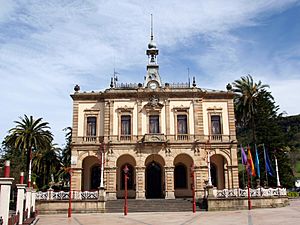Villaviciosa, Asturias facts for kids
Quick facts for kids
Villaviciosa
|
|||
|---|---|---|---|

Villaviciosa city hall
|
|||
|
|||
| Country | Spain | ||
| Autonomous community | Asturias | ||
| Province | Asturias | ||
| Comarca | Gijón | ||
| Founded | 17 October 1270 | ||
| Capital | Villaviciosa | ||
| Area | |||
| • Total | 276.23 km2 (106.65 sq mi) | ||
| Elevation | 662 m (2,172 ft) | ||
| Population
(2018)
|
|||
| • Total | 14,430 | ||
| • Density | 52.239/km2 (135.30/sq mi) | ||
| Demonym(s) | maliayo/a | ||
| Time zone | UTC+1 (CET) | ||
| • Summer (DST) | UTC+2 (CEST) | ||
| Postal code |
33300 and 33310 al 33318
|
||
| Official language(s) | Spanish | ||
Villaviciosa is a town and municipality in Asturias, Spain. Asturias is one of Spain's autonomous communities. A famous musician, José Ángel Hevia Velasco, was born here. Villaviciosa is well-known for making cider, a popular drink. The town also produces milk and welcomes many tourists. People love to visit for its beautiful nature and beaches.
Contents
Geography of Villaviciosa
Villaviciosa is located on the central eastern coast of Asturias. It shares borders with several other towns. To the west, it borders Gijón and Siero. To the south, it borders Sariego, Nava, Cabranes, and Piloña. To the east, it borders Colunga. The total area of Villaviciosa is about 276 square kilometers.
Population of Villaviciosa
In 2011, Villaviciosa had a population of 14,962 people.
History of Villaviciosa
Early History and Settlements
Long ago, in prehistoric times, many hill forts were built around Villaviciosa. Most of these forts were close to the ria, which is like a river mouth, near Rodiles beach.
During the 8th century, when the Kingdom of Asturias existed, people moved to areas like Amandi, Camoca, and Bedriñana. These places were often mentioned as part of the Maliayo territory.
Growth and Royal Charters
By the 13th century, the area started to grow again. On October 17, 1270, King Alfonso X The Wise signed a document. This document officially allowed people to settle in a place called Buetes. Around the same time, a group of monks called the Cistercian Order built the Monasterio de Santa María de Valdediós in the Boides valley.
Important Royal Visits
In the 16th century, a very important event happened. Holy Roman Emperor Charles V landed in Villaviciosa. He was on his way to Santander but a storm changed his course. He arrived at the port of Tazones and was hosted in the town. This was a big moment in the village's history.
Modern Era and Development
In the 19th century, Villaviciosa faced many attacks. French soldiers occupied the town several times during the Peninsular War. In 1835, the community was officially set up. The town's business grew a lot because of its location on the river. Back then, the river was easy to travel on by boat.
Parishes of Villaviciosa
The main town of Villaviciosa is also the capital of the municipality. It covers an area of 2 square kilometers.
Villaviciosa is divided into 41 smaller areas called parroquias or parishes. Here are some of them:
- Amandi
- Ambás
- Argüero
- Arnín
- Arroes
- Bedriñana
- Breceña
- Camoca
- Candanal
- Carda
- Careñes
- Castiello
- Cazanes
- Celada
- Coro
- El Busto
- Fuentes
- Grases
- La Llera
- La Magdalena
- Lugás
- Mar
- Miravalles
- Niévares
- Oles
- Peón
- Priesca
- Puelles
- Quintes
- Quintueles
- Rales
- Rozaes
- San Justo
- Santa Eugenia
- Selorio
- Tazones
- Tornón
- Valdebárzana
- Vallés
- Villaverde La Marina
- Villaviciosa
Important Buildings in Villaviciosa
Villaviciosa has several notable buildings that are worth seeing:
- Church of San Salvador de Valdediós
- Church of Santa Eulalia de la Lloraza
- Iglesia de Santo Tomás
- Monasterio de San Martín
Images for kids
-
Carlos I square
-
Church of San Salvador de Valdediós, a pre-Romanesque church
See also
 In Spanish: Villaviciosa para niños
In Spanish: Villaviciosa para niños









